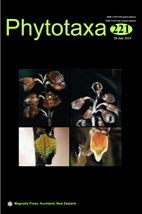Abstract
Two new species of Euphorbia subg. Chamaesyce sect. Anisophyllum are described and illustrated. Both are endemic to the Sonoran Desert of Baja California Sur, Mexico, and were previously determined as Euphorbia polycarpa. Their recognition is highly supported by both molecular and morphological data. Euphorbia vizcainensis occurs in the Vizcaíno and Magdalena subdivisions at elevations from 20 to 250 m. It differs from E. polycarpa in having rugose seeds with transverse ridges (vs. smooth seeds). It is most similar to E. pondii from which it is separated by features of the stipules, involucral appendages, and seeds. Euphorbia cerralvensis is restricted to the Cerralvo Island in the municipality of La Paz of the Central Gulf Coast subdivision, and occurs at elevations from 10 to 300 m. It also differs from E. polycarpa by having seeds with transverse ridges. Morphologically it is very distinct from other Euphorbia species in the region. Phylogenetic evidence suggests that it belongs to a clade with E. dentosa, E. leucophylla, E. petrina, and E. brandegeei, species from which it is distinguished by its suffrutescent ascending habit (vs. herbaceous prostrate habit).

